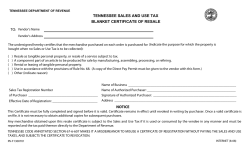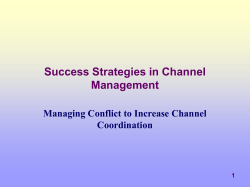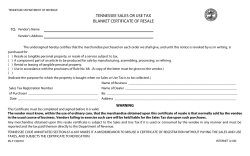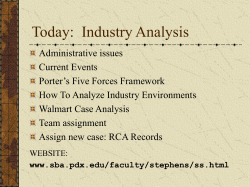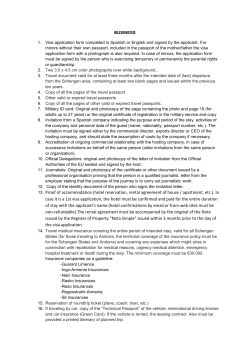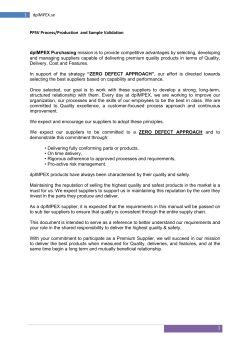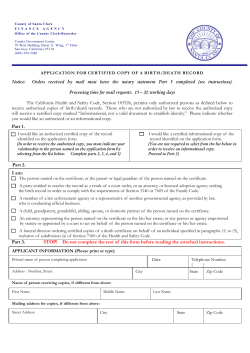
071 263 2963 086 658 0055
Tel: Fax: Email: Postal: CK: Vat: 071 263 2963 086 658 0055 info@thefoodsafetynetwork.co.za P.O. Box 10765, Aston Manor, 1630 2007/211803/23 4060241330 How to develop your food safety management system Welcome to our series to assist you with the development of your food safety management system. We trust that this column will be beneficial and we look forward to your comments and questions. Garbage in…Garbage out – know your suppliers At a recent SAAFOST lecture on aflatoxins by Prof. Mike Dutton, I was again reminded of the importance of knowing your raw materials and your suppliers. In the case of aflatoxins the problem starts with the ingredients and there is very little you can do once you have received this problem. His talk highlighted the importance of adequate supplier control. The quality and the safety of your product depends heavily on the standard of raw materials or ingredients you use. There are a few controls you should integrate into your supplier quality assurance process. 1. “Know who is who in the zoo” Make sure you buy from reputable suppliers. Stick with well-known brands and make sure you do proper checks on companies that are not as well-known. This process is not meant to exclude any suppliers but it is a measure of limiting your risks. In recent food safety issues relating to food contamination such as Sudan red and melamine contamination, the larger well known food companies have not been untainted. The difference being that they have recall mechanisms in place which helped them survive the crisis. If you decide to use a less well known brand then do the background checks such as asking for references from other customers. You can also request information relating to the supplier’s food safety system such as their food safety policy, their HACCP plan, the controls they have to ensure the safety of the ingredient they supply you. A good question to ask is “What food safety hazards are associated with this ingredient?” If the supplier has control over these hazards they will indicate what they are and the associated controls. It is not a good idea to buy from someone who knows less about the product than you do. A supplier visit/audit is always the best indication of whether the controls are actually in place but this is often not feasible. The condition of a truck or delivery staff hygiene can tell you a lot too. 2. Implement control where control is needed. We do not need to apply a shotgun approach to controlling suppliers. You should determine the risk associated with the raw material and then control the supplier accordingly. You may also find that some suppliers have good controls in place and therefore you do not need to apply extensive control measures whereas others do not apply any controls and hence you have to increase your efforts. You should conduct a risk assessment on the ingredients/raw materials and on the suppliers and implement controls appropriate to the risks. This risk assessment should then help you to justify why you sample one supplier with each delivery and why you accept a certificate of compliance with another. The output of step 1 and 2 will be your approved suppliers’ list. It is always a good idea to have a preferred supplier and an alternate supplier. This makes provision for the real world where there are stock shortages, breakdowns etc. © Von Holy Consulting | January 2009 | © The Food Safety Network| May 2010 3. Know and agree your requirements Specifications must be in place for all the raw materials you use. These should be your documents and not just the suppliers’ information. There may be a lot of information on their documentation which is irrelevant to you but there may be parameters they do not identify (sometimes intentionally) which are important to you. Microbiological specifications often fall into this category. You need to know what it is about the ingredient that is important to you. Perishable products always require control of micro-organisms and hence the permissible levels should be stated. Colour, flavour, temperature, packaging, ingredient listing should all be considered. You know what requirements your customers ask for – ask the same of your suppliers. Remember regulations relating to the permissible temperatures for the storage and delivery of food also apply to your suppliers. Get agreement of your specifications – they represent your conditions of purchase. Make sure this is in place considering the Consumer Protection Act. Look out for allergens that may be in your ingredients but yet are not declared on the packaging of your products. 4. Know the middle man but know the origin Many imported foods are handled via an agent. This is often a VERY grey area. Make sure you know exactly who the supplier is and that you are notified if this changes. The specification must be agreed with the agent. If you are importing foods or ingredients remember these products must comply with South African legal requirements to be used or sold in the country. Make sure you are familiar with what legal requirements apply to these imported foods to ensure you cannot be implicated in illegal trade activities. All imported foods must go through customs and you must insist on the correct documentation being supplied. If in doubt contact Port Health for clarification. 5. Check it at the front door. Your receiving inspection gives you an important point where you can exclude any hazards from entering your process – make sure it is an effective check. Ensure the person checking the deliveries is competent to perform the checks. Make sure the checks that are conducted are in line with what you specified on the raw material specification. Often on an audit, a company will conduct checks but the storeman does not have access to the specifications and the checks are often only weight or counting of items delivered. The batch number, the time of delivery, the weight and condition of the load, the type and condition of the packaging should be noted. The presence of decomposition, mould, unusual odours, dampness, undesirable levels/types of micro-organisms, dirt, insects, parasites, foreign bodies, pesticides, veterinary drugs, blown or leaking containers and severely damaged packaging should required a rejection(so this implies you should be checking for these things….). Even if your supplier issues you with a certificate, this does not relieve you of your responsibility for ensuring products comply with your requirements. 6. Certificate of what… There is a lot of confusion about which certificates should accompany products. Apart from any legal certification such as health certification for animal products, abattoir registration certificates etc, you can request either a certificate of conformance or a certificate of analysis to accompany the batch of product. A certificate of conformance is like a guarantee – the supplier will certify the product complies with the agreed specification but there may not be any analytical information. A certificate of analysis will usually state the results of some tests carried out on that batch of product only. A certificate of analysis is only valid for the batch and is only an indication of the status of the sample taken. In some case this is the correct option if a product can vary and you need to know the variation. Make sure you check the certificate against the specification – audits have highlighted that nonconforming product was received on a regular basis but not identified at receiving. What do you do if you cannot get a certificate – well then the testing becomes your problem and your risk analysis should highlight what controls you implement if any. As with any testing schedule, make sure you have enough information to make decisions on – a random test every 6 months is not management information. You may need to increase testing until you have trends. © Von Holy Consulting | January 2009 | © The Food Safety Network| May 2010 –2– 7. What to do with suppliers who misbehave When you find a problem with a raw material, action must be taken. If possible the product should immediately be returned. If this is not possible make sure you have a quarantine area to segregate the ingredient so it is not accidently used while you are trying to resolve the issue with the supplier. Stickers can also be used but make sure you have an effective system in place. Sometimes you may decide to handle the problem yourself and sort out poor quality vegetables as an example. You may also decide to use thawing chicken immediately rather than returning it. Regardless of the action you take, make a note of it and be sure to inform the supplier in writing. You should insist on a response to your complaint and the details of the corrective action taken to make sure it does not recur. Ongoing problems may require you to find an alternative supplier. Remember on the audit it will be up to you to demonstrate with records that you are dealing with the issue. It is a good idea to let your suppliers know you are monitoring them. 8. System certification vs. product certification A company may look for ways to improve their confidence in suppliers. The fact that you are having to implement a food safety system and be audited by a third party is your customer’s way of doing just that. You may decide to look for suppliers what have a HACCP system in place. Remember that a HACCP certificate can ONLY be issued by an accredited certification body. Ask for a copy of the certificate and confirm its authenticity with the issuing company. A HACCP certificate(SANS 10330:2007) or an ISO 22000:2005 certificate means the company have a documented HACCP system in place. It does not infer anything about the safety of their product nor does it imply their product is tested by the company issuing the certificate. The certificate cannot replace any specification you have or require. The same applies to BRC certification or AIB certification. You may choose to buy products that are SABS mark-bearing such as cleaning chemicals. This means the products are made in accordance with a national specification for the product and the product has been tested and found to be in accordance with the specification. Again request a copy of the certificate and authenticate it. The product certification scheme is product specific not a general certificate for all products. Make sure the one you buy is on the list. In both cases this certification is VOLUNTARY and NOT a legal requirement. Hope that helps. You may feel it is unfair to have to control your suppliers and your own process but many problems can be avoided if you do have this control. © The Food Safety Network| May 2010 © Von Holy Consulting | January 2009 | © The Food Safety Network| May 2010 © Von Holy Consulting | January 2009 | © The Food Safety Network| May 2010 © Von Holy Consulting | January 2009 | © The Food Safety Network| May 2010
© Copyright 2025

